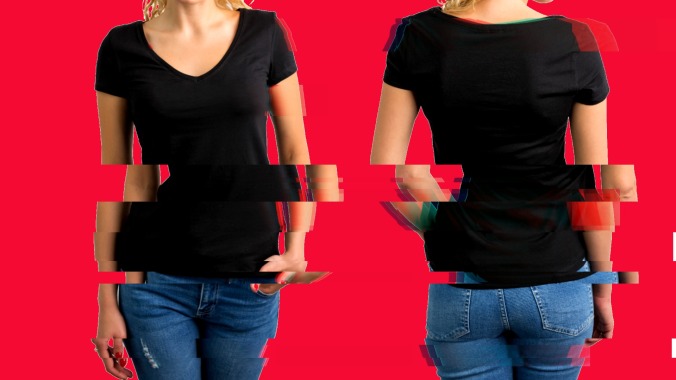Raging Against the Fitted Tee
The girls of the mid-2020s have no idea how good they really have it. They idolize Y2K fashion without respect for their elders, who lived through the "fitted tee" blight.
Photo: iStockphoto FashionIn Depth
If you’re looking for an icebreaker at a party (because “what conspiracy theory do you secretly buy into?” is too fraught a question these days) that is attended by at least one woman who grew up in the 1990s, might I humbly suggest bringing up the girl-cut tee. This is a move with a 100% success rate for me across three continents. “Oh God, yeah, I hate that,” says literally whichever woman I’ve asked about this. Yes, another unsuspecting millennial whose rage-candle I have lit about my grievance!
For the uninitiated, the “girl-cut” or “fitted” (or sometimes just “women’s”) t-shirt is characterized by a few specific design choices, often (but not always) appearing on a single cursed garment: a nipped-in waist; a long, bowed hemline that usually goes well past the standard waistline of a pair of jeans, threatening to reach one’s crotch; a slightly scooped neckline (to suggest the concept, if not the lived reality, of cleavage), and, probably most irritating, those teeny tiny cap sleeves with a a centimeter of fabric digging into your armpits and cinching like mini mountaineering sleeping bags around one’s biceps. (Here are some select examples.) Throughout the 1990s and 2000s, they could be spotted at malls, merch tents, sports games, camps and conferences, and apparel sites on the prehistoric internet, often with the same general design or logo as the men’s option but with inane, uncomfortable feminizing modifications. (To be clear, I’m not mad at the baby tee, which the luminaries at the New York Times declared officially back in November.) These shirts are designed, presumably, by someone who has only ever seen sketches of women in medical textbooks. They scream, I need you to help me carry things.
If it were a question of taste, maybe I would let things slide, find another hill upon which to die. But there are also clear practical downsides to these girly-pop tops. Besides being a fabric-based monument to the male gaze, you’re going to pit out immediately. I mean that literally. These are items of clothing that only work if you’ve had your armpit pores chemically plugged, otherwise, there will be sweat stains in under five wears.
Additionally, in the course of my research riling people up at parties, several women complained to me that the actual material of the shirts was worse—a fact later confirmed by my friend, a clothing designer who’s worked on items that later hit the shelves of Walmart, Target, and Macy’s.
-

-

-

-

-

-

-

-

-

-

-

-

-

-

-

-

-

-

-

-

-

-

-

-

-

-

-

-

-

-

-

-

-

-

-

-

-

-

-

-







































